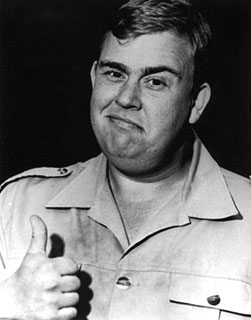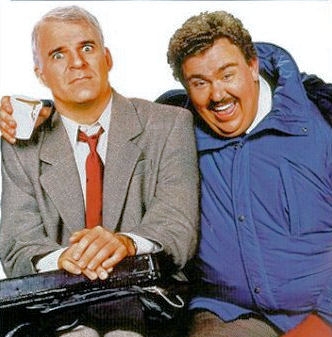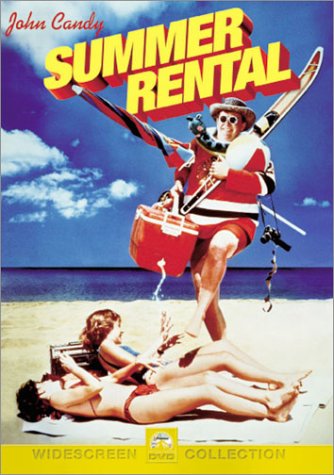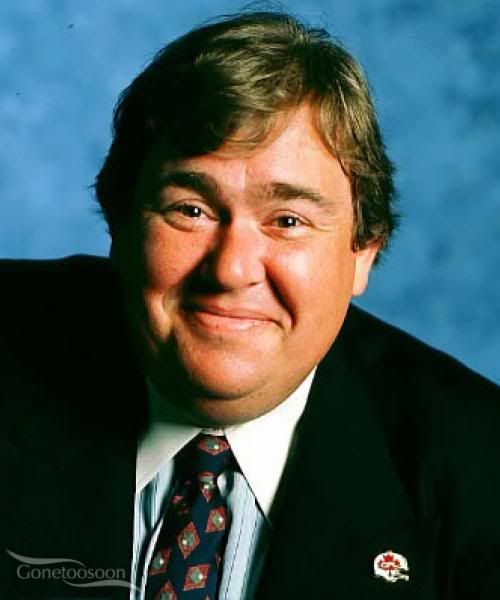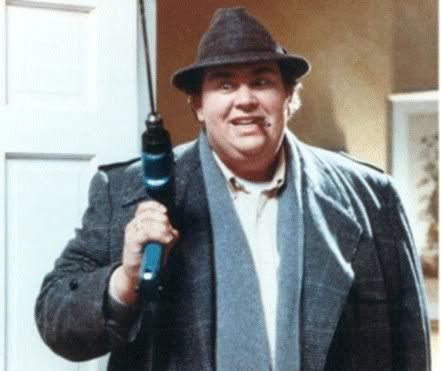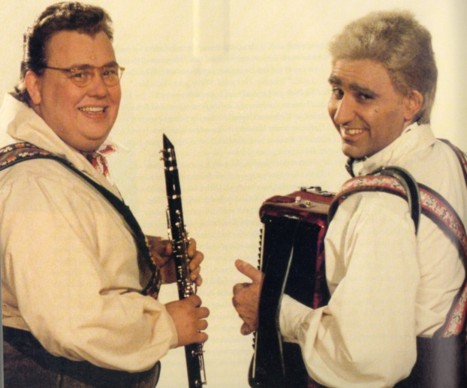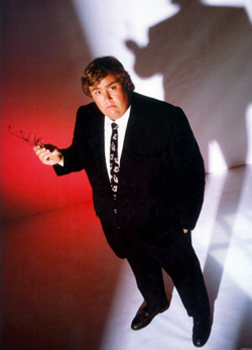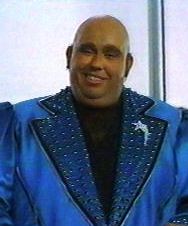
George Halas
No other team has had more impact on the game of American football than the Chicago Bears. They were the first participants in both postseason and indoor play. One of their players invented the modern day protective padding that is still used to this day. Their success has been so great that they have put 25 men into the Pro Football Hall of Fame so far, which is the most ever in NFL history.
The first name and image on the organization is George "Papa Bear" Halas. He was an excellent athlete who played a dozen baseball games with the New York Yankees before an injury forced his retirement. That injury helped give propel the game of football that so many love.
While working with the A.E. Staley Company, a manufacturer of starch, he played both baseball and football with them. He was sent as a representative of the company to a meeting to form the fledgling American Professional Football Association in 1920. The APFA would then become the NFL two years later.
Though the team had success their first season, as the Decatur Staleys, they lost money and Halas was given control of the team. He moved them to Chicago in 1921, where they won the leagues second ever championship. They then began using Wrigley Field as their home stadium, so Halas renamed them the Bears because of the Chicago Cubs of Major League Baseball.
"Papa Bear" was not only the owner, but he was the head coach and a star player. He once stripped Hall of Famer Jim Thorpe of the ball and ran 98 yards for a score. This achievement stood as an NFL record for 49 years.
Despite all the success the Bears were having, the professional game paled in popularity to the college game. Halas then got hometown hero Red "The Galloping Ghost" Grange to sign with the Bears after he graduated from Illinois University. Grange was paid $100,000 to barnstorm with the team for 19 games over 67 days in 1925. Considering players were paid $100 or less a game, his salary was considered astounding then.
The games helped the NFL gain more notoriety from the media and fans, helping to pave the way to the success the league enjoys today. Grange left the team in a dispute, and founded the first American Football League, which lasted one year after he hurt his knee versus the Bears. He would return to play for Halas until he retired in 1934.
By this time, the NFL was an established professional sports league. Chicago led the way in making this happen. The Bears would capture six more titles from 1932 to 1946. The crosstown rival Chicago Cardinals also won two championships, though their first title is widely disputed to the point many believe the Pottsville Maroons are the true champions of the 1925 season.
After he retired as a player, Halas stayed the owner and coach until 1983. He did step down as coach intermittently, but was at the helm 40 of 48 years before he finally stopped coaching after 1967. One of the times he stepped down was to serve in the Armed Forces during World War II.
The Bears biggest rivals are the Green Bay Packers. Halas turned up the heat in 1921 by having the Packers thrown out of the league. He was intent on signing Hunk Anderson, but found out that Anderson had played some for the Packers. He charged them with tampering, which led to Green Bay's expulsion for one year. Anderson ended up playing and being a head coach for the Bears.
The Bears currently hold a 90-82-5 edge in their series, with a scoring edge of just 116 points. Their battles are legendary, where Hall of Fame Packer coaches Curly Lambeau and Vince Lombardi often voiced their displeasure of the Bears. This was easily reciprocated by Halas through the years.
One important link to the Bears was the University of Chicago. The term "Monsters of the Midway" was initially used on the colleges football team that was coached by the legendary Amos Alonzo Stagg. His successor was the legendary Clark Shaughnessy, who took the mostly dormant T-formation and had it focus mostly on the quarterback. This led to teams eventually abandoning the single wing formation that was in use then.
The Bears had actually already used the T-formation in a different style before Shaughnessy helped them. Ralph Jones, who introduced the Bears to Bronko Nagurski, was the Bears head coach from 1930 to 1932. He is the first coach to send his wide receivers, tight ends, and running backs in motion before the snap of the ball. The helped the Bears capture the 1932 championship, and Halas took over the next year after Jones retired.
Shaughnessy worked alongside Halas as a consultant, and helped him scout Hall of Fame quarterback Sid Luckman while still in college during 1939. The T-formation helped the Bears capture four titles in six seasons. After coaching in college and the pros from 1940 to 1950, he officially joined the Bears in 1951 and stayed with them in the front office for 11 years. Luckman is still the Bears all time leader in most passing categories.
Another Bear, Jim Dooley, was a former player turned coach who invented the nickel package on defense. The nickel gave birth to the dime package eventually, which also can be attributed to the Bears influence on the game.
After winning the 1963 championship, the Bears went 22 years before capturing another title. One of the final moves Halas made before dying in 1983 was hiring Bears Hall of Famer Mike Ditka as head coach in 1982. Ditka oversaw a 1985 team so good, that the term "Monsters of the Midway" was temporarily reborn on their way to winning Super Bowl XX.
Since then, the team has had 11 winning seasons, nine postseason appearances, and one Super Bowl loss in 2006. Last season, they traded their 2008 starting quarterback, two first round draft picks, and a third round draft pick to acquire quarterback Jay Cutler. Though his first year in Chicago was not what most had envisioned, there is hope he can return the franchise to once again taste the fruits of a title and add a tenth championship trophy to their legacy.
Remember : This is a list of football legends who are not yet members of the Pro Football Hall of Fame.
Quarterback : Ed Brown

Brown was drafted in the sixth round of the 1952 draft by the Bears after an interesting collegiate career. He attended the University of San Francisco, and played on a team that included such NFL legends like Ollie Matson, Gino Marchetti, Bob St. Clair, Dick Stanfel, and Burt Toler. Matson, Marchetti, and St. Clair are members of the Pro Football Hall of Fame, Stanfel was a five time Pro Bowler, member of the 1950's NFL All Decade Team, and future Bears offensive line coach from 1981 to 1992, and Toler was the first African American official.
In addition to having five more teammates make the NFL, including Pro Bowl safety Joe Scudero, they were coached by future NFL coach Joe Kuharich. The schools athletic publicist was future NFL commissioner Pete Rozelle. Because the school had African American players, they were not invited to any major bowl games despite being undefeated. They refused to send a squad of just Caucasian players to appease bigots in that era, and ultimately shut down their football program after 1951. The school reopened the program a few times in the 1960's and 1970's as a Division II program, but has never fielded a varsity team after that.
Though he did not join the Bears until 1954, after serving two years with the Marines, Brown spent his rookie year playing some defense and as a part time punter. He did throw three touchdown passes on 17 attempts, and intercepted a pass as well that year. Chicago then lost quarterback Zeke Bratkowski to the military in 1955, and Brown beat out future Hall of Famer George Blanda for the starting job.
He made the Pro Bowl that year despite throwing 10 interceptions versus nine touchdown passes. He also ran for a career high 203 yards and averaged 40.1 yards on 44 punts. He would return to the Pro Bowl the next year for the final time with perhaps his best season.
He led the NFL in completion percentage, touchdowns thrown percentage, yards gained per attempt and completion, adjusted yards per attempt, and quarterback ranking. He also averaged 39.1 yards on 42 punts. Chicago would reach the championship game against the New York Giants.
The field in Yankee Stadium was covered in ice, and the Giants came out wearing sneakers while the Bears wore cleats. This had occurred 22 years earlier in New York, where the Giants won in the legendary "Sneakers Game". The Giants strategy worked again, sacking Brown innumerous times and intercepting him twice in their 47-7 win. The game ended up being tagged the "Second Sneakers Game".
Bratkowski returned to the Bears in 1957 and began to push for playing time, starting in four games. Brown then would start in 32 of a possible 36 games over the next three years. Twice he led the NFL with the longest pass completion, and continued to be the full-time punter. He led the NFL with 64 punts in 1959, averaging 41.2 yards per attempt.
The Bears acquired Billy Wade in a trade before the 1961 season, and he replaced Brown after the fifth game as the starter. Brown's last start saw him toss two touchdown passes, including an 84-yarder, in a comeback victory over the Baltimore Colts. He continued to punt and even served as a place kicker in Wade's first start. He made the only field goal and extra point of his career in the game.
The Pittsburgh Steelers needed a quarterback in 1962, so they traded for Brown in a deal that landed Chicago future great Bobby Joe Green. He served as a backup to Hall of Famer Bobby Layne that year, but did start in three games. He also served as the Steelers punter and booted a ball for a career best 78 yards that year.
Layne retired after the 1962 season, so Brown was named the starter. He led the NFL in yards gained per completion and threw a career high 21 touchdown passes and 2,982 yards in 1963. His Pro Bowl receiver, Buddy Dial, and tight end, Red Mack, both averaged well over 21 yards on 85 combined receptions.
He was replaced by Bill Nelson at quarterback in 1964, and he also split punting duties with Ed Holler. He was then traded the Baltimore Colts right before the last game of the season because Hall of Famer Johnny Unitas and his backup Gary Cuozzo were both injured.
The Colts needed to win because they were one game behind the Green Bay Packers in the standings. Not knowing the playbook nor his teammates, he handed the ball off most of the game against the struggling Los Angeles Rams. The Rams were leading 17-10 in the fourth quarter, so Brown unleashed a 68-yard bomb to Hall of Fame tight end John Mackey to tie the score. The Colts would later kick the winning field goal. Brown attempted five passes all game, and completed three.
The Packers ended up in a 24-24 tie against the San Francisco 49ers that week, thanks to a late touchdown pass from John Brodie, so they found themselves in a divisional tie with the Colts. Baltimore's Hall of Fame coach Don Shula had to go with running back Tom Matte at quarterback because the rules then made Brown ineligible for postseason play. Green Bay had Brown's former Bears teammate Bratkowski starting for injured Hall of Famer Bart Starr. The Packers won 13-10 in overtime, as Matte struggled, then went on to win the NFL Championship. Brown retired at the end of the year.
He still ranks sixth in Bears history in career passing yards, and he ranks third in wins and for the longest completion. His 63 career touchdown passes with Chicago is tied for the fourth most ever, and his two Pro Bowls is the second most ever by a Bears quarterback. Though he never won a championship with Chicago, Ed Brown had a cannon for an arm and leg. He is one of the best to ever have played for the Bears.
Johnny Lujack, Jim McMahon, Solly Sherman, Young Bussey, who was killed in WWII, Bernie Masterson, Joey Sternaman, Bobby Douglass, and Billy Wade deserve mention.
Fullback : Rick Casares

Casares was drafted in the second round of the 1955 draft by the Bears. His impact was immediate, leading the NFL with a career best 5.4 yards on 125 carries and running for a career long 81 yard touchdown. He also led the team with 625 rushing yards, earning the first of his five consecutive Pro Bowl appearances.
He exploded in his second season to even greater heights. He led the NFL with 234 carries for 1,126 yards, 12 rushing touchdowns, 14 total touchdowns, and an average of 93.8 yards rushing per game. All are career high marks, and he was named First Team All-Pro. His 1,126 rushing yards were the second most in NFL history at the time, and he is also known as the last Caucasian to lead the league in rushing.
Chicago reached the title game on the strength on his running, but lost in the "Second Sneakers Game" to the New York Giants 47-7. Casares provided the Bears their only points on a nine yard run, but was mostly kept in check by New York's defense and weather with 43 yards on 14 carries.
Though he never exceeded 700 yards rushing in a season again in his career, he did lead the NFL with 204 carries in 1957. He also scored 12 touchdowns in 1959,. By the time the 1961 season ended, he was no longer the effective runner he once was and became mostly a blocking back the rest of his career.
In the Bears 1963 championship season, he was a backup to Pro Bowl fullback Joe Marconi. He did not touch the ball in their 14-10 win over the Giants. He joined the Washington Redskins for three games in 1965, then the Miami Dolphins for six games the next year. He scored the last touchdown of his career off a pass reception that year, then retired.
When he left the Bears, Casares was their all-time leading rusher with 1,386 carries for 5,657 yards and 49 touchdowns on the ground, as well as 59 total scores. He held those records until Hall of Famer Walter Payton passed him. Casares still ranks third in all categories.
Chicago has had countless great fullbacks, and perhaps it all starts with Hall of Famer Bronko Nagurski. Rick Casares can certainly lay claim to being the second greatest fullback to ever wear a Bears uniform.
Bill Omanski, Roland Harper, Joe Marconi, John Petty, Chick Jagade, Pete Martinovich, Jack Manders, John Dottley, Norm Standlee, Joe Maniaci, Matt Suhey, and Gary Famiglietti deserve mention.
Halfback : Neal Anderson

Anderson was the Bears first round draf choice in 1986, but he was rarely used in his rookie year as a backup to Hall of Famer Walter Payton. He did score once on a pass reception. He played fullback the next year, which was shorten because of a players strike. He ran for 587 yards, caught 47 passes, and scored six times.
Payton retired before the 1988 season started, so Anderson was named the starting halfback. He responded with a Pro Bowl season after grounding out 1,106 yards and scoring a career best 12 rushing touchdowns. One touchdown came off an 80 yard run, which led the NFL. It was the first of his four consecutive Pro Bowl seasons.
His best season came in 1989. He set career best marks of 1,275 rushing yards, 50 receptions, 15 total touchdowns, and a 4.7 yards per carry average. He followed that up with his last 1,000 yard season, scored 13 times, and averaged a career best 11.5 yards on 42 receptions.
Though he made the Pro Bowl for the final time in 1991, he missed three games because of injuries. The injuries began to mount up on him, so he retired at the end of the 1993 season. His 1,515 carries for 6,166 rushing yards, 51 rushing touchdowns, and 71 total touchdowns are the second most in frachise history. His 303 receptions are the second most ever by a Bears running back, and ranks sixth best overall.
Though he was brilliant for a short time, he was excellent, consistent, and explosive when healthy. His career often draws comparisons to Bears Hall of Famer Gale Sayers, another great running back who had his career cut short because of injuries. Chicago has had a long line of legendary running backs, yet it is Neal Anderson who tops all but the legendary Payton.
Ray Nolting, Willie Galimore, Pete Stinchcomb, Frank Maznicki, Hugh Gallarneau, Gene Ronzani, Bob Swisher, John Hoffman, Anthony Thomas, Thomas Jones, Harry Clark, and Beattie Feathers, the first running back to ever gain 1,000 yards in a season, deserve mention.
Wide Receiver : Harlon Hill

Hill was a 15th round draft pick of the Bears in 1954. He earned a starting job in camp, and caught four passes for 140 yards in his NFL debut. One catch went for a 64 yard touchdown.
He was named Rookie of the Year and the first of three consecutive Pro Bowl games after leading the NFL with 12 touchdown receptions and a 25 yards per catch average. He gained 1,124 yards on 45 receptions on a team that used three different quarterbacks that year.
The National Enterprise Association began polling the players of the NFL in 1955 to vote for the leagues most valuable player, which is the truest way to determine the most worthy rather than the Associated Press media voted award. Hill was the first ever recipient after leading the NFL with nine touchdown catches. He was also named First Team All-Pro.
Hill had perhaps his best season in 1956, making his last Pro Bowl and his last First Team All-Pro nod. He led the NFL with a 79 yard reception and a 24 yards per catch average, while also having a career high 47 receptions for 1,128 yards. He also had 11 touchdowns, which helped Chicago reach the championship game before losing to the New York Giants.
His next two years were filled with injuries that caused him to miss eight games total. It also took away his explosiveness, though he did lead the NFL with a career long 88 yard touchdown catch in 1959.
Chicago released him at the end of the 1961 season, so he joined the Pittsburgh Steelers for seven games in 1962. He was traded to the Detroit Lions, then retired at the end of the season. He left the Bears as their all time leader in receptions and receiving yards. He now is second in franchise history in receiving yards and touchdown catches, as well as 11th in receptions and sixth in total touchdowns.
Harlon Hill appeared to be well on his way into Canton in his first three seasons. His soft hands and top-notch speed are still very much a part of the Bears lore. Injuries and a drinking problem hindered him game at its heights, but he may be the greatest wide receiver in the franchises long history. There is a trophy named after him that honors the best player in division II football.
Wide Receiver : Ken Kavanaugh

Kavanaugh was drafted by the Bears in the third round of the 1940 draft after becoming the first college lineman to ever win the Knute Rockne Award. He averaged 23 yards on 12 receptions, scored three times, and intercepted the only ball of his career as a rookie. He contributed a 30 yard touchdown catch in the Bears 73-0 blow out of the Washington Redskins in the championship game, and was named a Pro Bowler.
He followed that up the next year averaging 28.5 yards on 11 catches. Six went for touchdowns, and he scored another on a 42 yard fumble recovery in the Bears 37-9 victory over the New York Giants. He was named to his final Pro Bowl as well.
When America became involved in World War II, many NFL players enlisted. Kavanaugh was one of them. He became a heroic pilot who flew over 30 missions and earned the highest medals possible for a pilot.
He returned to the Bears in 1945, and showed he had not lost his explosiveness by averaging 21.7 yards on 24 receptions while scoring six times. He averaged a career low 18.7 yards on 18 catches the next year as the Bears won the NFL Championship. His 21 yards touchdown snag opened the scoring in the title game, and his 32 yard catch set up another score in the Bears 24-14 victory over the Giants.
He had perhaps his finest season in 1947. He led the NFL with 13 touchdowns, all coming on receptions. It still stands as a team record to this day, though Dick Gordon tied it in 1970. He also set career highs with 32 receptions for 818 yards. One catch was a career long 81 yard score. He averaged a whopping 25.6 yards per catch, and this is still a franchise record.
After scoring six times on 19 balls the next year, he excelled again in 1949. He led the NFL with nine touchdown catches, matched his career long reception of 81 yards, and averaged 22.6 yards on 29 receptions. After averaging 19.5 yards on 17 balls the next year, he retired as a player, but remained with the team as a receivers coach. He joined the Giants as a coach in 1955, and was a part of the team that defeated the Bears in the 1956 championship game. He remained with the organization until 1999.
Ken Kavanaugh is a member of the NFL's 1940's All Decade Team. He holds the Bears records for most touchdown receptions in a career with 50, and in a season with 13. His career average of 22.4 yards per reception is a team record, and is his season average in 1947 of 25.6 yards per catch. His two Pro Bowls are the second most by a receiver in Bears history.
Johnny Morris, Dick Plasman, Jim Keane, James Scott, Dennis McKinnon, Gene Schroeder, Hampton Pool, Marty Booker, Bill McColl, Curtis Conway, Wendall Davis, Bill Karr, Willie Gault, Jim Benton, who was the first to have 300 yards receiving in a game and held the record for 40 years, and Dick Gordon deserve mention.
Tight End : Jim Dooley

Dooley was the Bear first round draft choice in 1952. He spent that season playing safety on defense, and intercepted five balls. He was moved to offense the next season, and he had a career best 54 receptions for 841 yards. His 1954 saw him average a career best 19.4 yards on 34 receptions and score a career high seven times.
He then joined the Air Force to serve in the military in 1955. When he returned to the Bears the next year, there were only three games left on the schedule. Chicago reached the NFL Championship game, but lost to the New York Giants 47-7 in the infamous "Second Sneakers Game". Dooley hauled in six balls for 66 yards in the game.
He remained productive over the next three years that he played, though missing the 1958 season due to an injury. He collected 114 passes over that time, as the Bears eventually moved him into the tight end position. He is considered to be the first pure tight end in Bears history. After contemplating retirement at the end of the 1960 season, he was coaxed back onto the field for one more year before retiring as a player permanently.
He joined the Bears coaching staff as the receivers coach in 1962. Chicago would win the championship in 1963. He was named the Bears defensive coordinator in 1966, where he invented the "Dooley Shift". This formation is now known as the nickel package, where an extra defensive back replaces a linebacker on obvious passing downs.
Chicago named him their head coach in 1968, a job he held four years and finished with a 20-36 record. He was dismissed at the end of the 1971 season, becoming the first Bears head coach ever to be fired. He rejoined the Bears in 1981 as an offensive consultant who scouted other teams on film, helping them win Super Bowl XX in 1985.
Hall of Famer "Iron" Mike Ditka is the only Bears tight end to appear in the Pro Bowl. There have been several good tight ends since, but I picked Jim Dooley because he is the best of the group and also for all he did for the team as a coach too. His 211 career receptions still ranks 12th best in franchise history, and his 3,172 yards ranks 11th best.
Eggs Manske and Bo Farrington deserve mention. In 1938, Manske was traded to the Pittsburgh Pirates for the draft pick that turned out to be Hall of Fame quarterback Sid Luckman. He never played in Pittsburgh, and returned to the Bears that year.
Tackle : Lee Artoe

Artoe was drafted in the 11th round in 1940 by the Bears. He played right away as a right tackle on offense and defense, and also shared kicker duties for them. He was a drop-kick specialist, and he hit a 52 yard attempt. No Chicago Bear has ever drop-kicked a field goal farther, and he held the team record for longest field goal for 35 years. The Bears would end up clobbering the Washington Redskins 73-0 in the championship game.
His first three years in the league saw him named to the Pro Bowl each season. Chicago repeated as champions in 1941 by defeating the New York Giants 37-9, and are considered one of the greatest teams ever. They went back to the championship the next season, but lost to the Washington Redskins 14-6. He provided the Bears their only points by taking a fumble recovery 52 yards for a touchdown.
After the 1942 season ended, many players elisted in the armed services because of World War II. Artoe was one of those men, serving as a lieutenant in the Pacific theater with a underwater demolition crew in the U.S. Navy. He would not return to the NFL until 1945.
When he returned, he started in six of the nine games he played. Dissatisfied with his contract, he became the first established NFL star to jump to the rival All American Football Conference. He signed with the Los Angeles Dons in 1946 for $15,000. After playing two seasons with them, he joined the original Baltimore Colts, of the AAFC, and was a player-coach for one year. He then retired.
Artoe was known as both a character and hard nosed player. His frequent fights with opposing players and penchant for cursing often had him visiting the office of the president of the NFL. He once criticized the league for scheduling a Pro Bowl too close to Christmas, often complained about referees, and was levied several fines by the NFL.
No other Bears offensive tackles, besides Hall of Famers Joe Stydahar and George Connor, have appeared in more Pro Bowls than Lee Artoe. His losing two years because of the war probably cost him more appearances and he possibly lost more opportunities if it weren't for the notoriously stingy Halas not giving him a pay raise to prevent his jumping to the AAFC.
Tackle : James "Big Cat" Williams
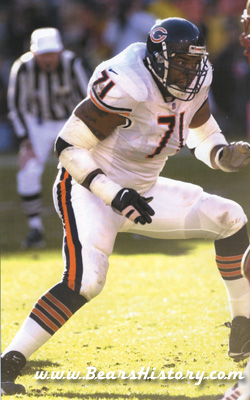
Williams joined the Bears in 1991 as a undrafted free agent rookie. He was initially put at defensive tackle, and saw significant action. He had a sack and blocked a field goal attempt. He didn't see much action the next year, and Chicago's coach Dick Stanfel thought Williams could play on offense.
His first year on offense was in 1993, and he saw some action in the three games but spent the rest of the year inactive to learn his new position better. He earned the starting job the next year, and missed a start in week nine but still played. He then started in 134 straight games from that point on until he retired in 2002.
He was honored as a Pro Bowl player in 2001, and was also named Second Team All-NFL. His work at special teams throughout his career also was excellent. He used his 6'7" frame to block at least eight field goal attempts in his career.
Though there have been several excellent tackles in Bears history who won't be inducted into Canton, I chose the Big Cat for his dependability and consistency. His coming from virtually nowhere to make the team and play both sides of the ball shows his excellence.
John Federovich, Herman Lee, Jimbo Covert, Ed Kolman, Del Bjork, Kline Gilbert, Jack Torrance, Hugh Blacklock, Bill Wightkin, Fred Davis, Bob Wetoska, and Keith Van Horne deserve mention.
Guard : Ray Bray
Bray was drafted in the ninth round by the Bears in 1939. He spent his first two years mainly backing up Hall of Famer Danny Fortmann and Pro Bowler George Musso, and himself was named to the Pro Bowl in 1940. Chicago would win the NFL Championship that year by dominating the Washington Redskins 73-0.
The Bears would win the championship again in 1941 after defeating the New York Giants 37-9. Bray had been named the starting right guard that year, and was once again named to the Pro Bowl. The Bears went back to the championship the next year, but were defeated by the Redskins.
Many players were called into service because of World War II, and Bray was no exception. He was out of the NFL until 1946 serving with the Navy, but he returned to claim his starting job that season and help the Bears capture their last championship until the 1963 season.
Bray continued to be a steady and excellent player for Chicago for many years. He returned to the Pro Bowl in 1950 for both his play as an offensive guard and defensive middle guard. Chicago played him just on defense the next year at defensive tackle, and he made his final Pro Bowl squad. He then joined the Green Bay Packers in 1952, and retired at the end of the year.
Ray Bray has almost been inducted into Canton several times. He is one of the most nominated players ever, but has yet to be enshrined. He is a member of the Helms Hall of Fame, and his three Pro Bowls as a guard are the second most in team history. He is one of the best who ever wore a Bears uniform, and he may be in Canton now if the war did not take away three years of his football career.
Guard : Joe Kopcha

Kopcha joined the Bears as a undrafted free agent in 1929, and ended up starting in nine of the 12 games he played at right guard. Chicago played 15 games that year, as the NFL was still trying to gain credibility and fans.
He was in medical school at the time, so the Bears had him assisting the trainer and gave him an extra $20 a week. Trying to prevent himself from getting injured, he configured the cheap materials used for padding in those days by adding more leather and foam. A representative from the Spalding equipment company saw this and asked Kopcha what and how he was doing this procedure.
He left the team at the end of the season and spent two years at medical school. During this time, Spalding made a fortune off of his ideas for shoulder and shin pads. Kopcha was quoted to have said he did not regret not having a patent on his idea, and was proud it helped prevent countless players from incurring injuries to hinder their quality of life.
He returned to the Bears in 1932, and started in nine if 12 games again. Chicago would end up winning the championship that year by defeating the Portsmouth Spartans in the first postseason game in NFL history. Previous champions were based on their records, but the teams had to play a tiebreaker game because they had tied each other in both regular season games. It was also the first football game ever played indoors.
The Bears would win the championship again in 1933, and Kopcha was named First Team All-Pro. It is known as the year the NFL broke away from college football rules and instituted their own. The goalposts were moved to the goal line and the league split the teams into two divisions so there could be a championship game because of the success they had the year before.
The Bears defeated the New York Giants 23-21 in what is called the first NFL Championship game ever. They won it in the last minute on a hook and lateral play when Bronko Nagurski passed it 13 yards to Bill Hewitt, who then shoveled it to Bill Karr. Karr took it six yards for the winning score. Hewitt and Nagurski are both members of the Hall of Fame.
Chicago went back to the championship game the next year, but the Giants exacted their revenge by winning 30-13 in the famous "Sneakers Game", where the Giants wore sneakers as opposed to the cleats the Bears wore on a field of ice caused by freezing rain. Kopcha was again named First Team All-Pro, and he even caught two passes for 24 yards.He would be again be named First Team All-Pro in 1935. It was his last year in Chicago, as he joined the Detroit Lions the next year after requesting a trade there so he could intern at a hospital there. He then retired at the conclusion of the season.
His three First Team All-Pro honors are the second most by a guard in team history behind his successor, Hall of Famer Danny Fortmann. It is also tied with Hall of Famer Stan Jones. He may have had more if he had not had to leave the game for a few seasons.
After he retired, he was a founder of the Pro Football Research Association, whose mission is to preserve the memory of players in the Early NFL. No one can deny that Joe Kopcha played a very important role during a crucial time in NFL history with an impact that can be seen to this day on every football field in the world.
Dick Barwegan, Al Baisi, Bill Hughes, Al Carlson, Aldo Forte, Zuck Carlson, Ruben Brown, Hunk Anderson, Hal Lahar, Chuck Drulis, Tom Thayer, Jim McMillan, and Mark Bortz deserve mention.
Center : Jay Hilgenberg

Hilgenberg joined the Bears as a undrafted free agent rookie in 1981. He spent his first two years backing up veteran Dan Neal, then split time with him in 1983. He was named the starter in 1984, a honor he would hold the rest of his Bears career.
He made his first of seven straight Pro Bowls in 1985. That season was the year the Bears won Super Bowl XX. They had the first ranked running game in the NFL that year, and Hilgenberg was a big part of the reason.
He was named First Team All-Pro in both 1988 and 1989. He missed the first two games of his career in 1990, but still was named to the Pro Bowl. He left the Bears after his final Pro Bowl season the next year to play for tthe Cleveland Browns in 1992. After starting every game that season, he joined the New Orleans Saints in 1993. He played in nine games, but started six, then retired.
No other Bears center has went to the Pro Bowl more than Jay Hilgenberg. His seven appearances is tied for fourth overall in franchise history, and his two First Team All-Pro honors is tied with George Trafton as the second most by any Bears center behind Hall of Famer Clyde "Bulldog" Turner.
His helping open holes for such great running backs like Hall of Famer Walter Payton and Pro Bowler Neal Anderson are one display of his excellence, as was his amazing durability that had him start in 122 of a possible 124 games over nine years at the demanding center position.
George Trafton, Ookie Miller, Chet Chesney, Frank Bausch, Mike Pyle, Al Matuza, Dan Neal, and Larry Strickland deserve mention.
Defensive Tackle : Fred Williams
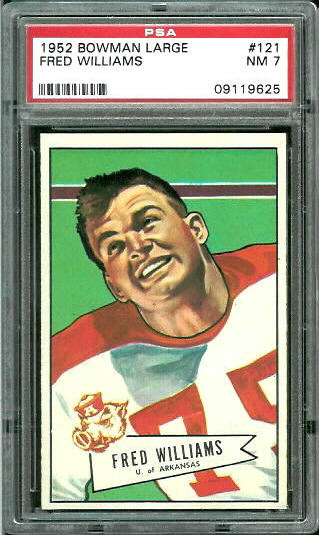
Williams was drafted in the fifth round of the 1952 draft by the Bears. He earned a starting job immediately and was outstanding. He was named to the Pro Bowl after he intercepted a pass and rumbled 54 yards. He returned to the Pro Bowl the next year as well.
Chicago needed help along their offensive line in 1954, so Williams was moved to that side of the ball to play guard. This experiment lasted one season, as he was permanently moved back to defensive tackle the following year.
He became the constant stalwart on the interior of the Bears defense in the 1950's. He intercepted another pass in 1956, returning it 11 yards. The 1958 season may have been his best, as he was named to the Pro Bowl and named First Team All-NFL by The Sporting News. He returned to the Pro Bowl for the final time of his career in 1959.
He was injured most of 1963, playing in just five games, but was able to suit up at the end of the year and help the Bears win the NFL Championship. He then joined the Washington Redskins the next year, and played two more seasons before retiring.
No other defensive tackle in Bears history has gone to more Pro Bowls than the four Fred Williams played in. He was excellent against the run, and kept blockers away from Hall of Fame middle linebacker Bill George. He teamed up with Hall of Famers like Doug Atkins and Stan Jones along the Bears defensive line in his career, as well as with Bears legend Ed Sprinkle. Williams may very well be the best defensive tackle in team history.
Defensive Tackle : Wally Chambers
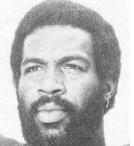
Chambers was the Bears first round draft choice in 1973, and his impact was immediate and tremendous. He was so dominating that he was named the the Pro Bowl and became the first Bear ever to be named Defensive Rookie of the Year.
After a good 1974 season, he returned the Pro Bowl in both 1975 and 1976. He was also named First Team All-Pro in 1976. There were few defensive tackles in the league better than the 6'6" 250 pond Chambers. He then suffered a devastating knee injury in 1977 that limited him to four games.
Chambers was then traded the Tampa Bay Buccaneers in 1978 for a first round draft pick and tight end Bob Moore, and was used as a reserve defensive end mostly that year. The pick Chicago got turned out to be Hall of Famer Dan Hampton. Chambers earned the starting job the next year, and Tampa Bay would make it to the NFC Championship before losing. He then retired.
Wally Chambers is the first defensive tackle in Bears history to be named First Team All-Pro, and his three Pro Bowls is the second most ever by a Chicago defensive tackle. He was, for a short time, as dominant a defensive player that there ever was at his position.
Steve McMichaels, Jim Osborne, Dick Evey, Jim Flanagan, Ted Washington, William Perry, and Bill Bishop deserve mention.
Defensive End : Ed "The Claw" Sprinkle
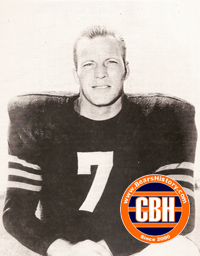
Sprinkle was signed as an undrafted free agent by Chicago in 1944 because Hall of Fame Bears center Clyde "Bulldog" Turner recommended him to owner/ coach George Halas. Turner had attended the same college, Hardin-Simmons, as Sprinkle and was familiar with him.
He was brought along slowly initially to gain weight and muscle, but it became quite apparent that Sprinkle excelled on defense. His was called "The Claw" because of his ability to shed blockers with his strong left arm from his right defensive end position.
His 1946 season saw him catch the first seven passes of his career for two touchdowns. He would gather in 25 more balls up until 1952, but his impact on defense was valuable that Chicago limited his time on offense. The Bears would end up winning the 1946 NFL championship by defeating the New York Giants 24-14.
The Bears tied the Los Angeles Rams for first place in their division in 1950, so the teams battled in playoff game that the Rams won 24-14. It would be the last time that Sprinkle played in the postseason, but the first year he attained a Pro Bowl nod. He would return to the Pro Bowl in each of the next three years.
It was also the first year he wore the number seven on his jersey, the same number that Halas had worn in his days of a player. Though other players wore that number since, it is considered a retired number now in honor of "Papa Bear" Halas.
By the time he retired after the 1955 season, he had a career where he played with some of the greatest players in NFL history. Men like Turner, Bill George, Sid Luckman, George Connor, Doug Atkins, and George Blanda played defense with him and are all members of the Pro Football Hall of Fame.
Sprinkle was dubbed "The Meanest Man in Pro Football" in his playing days. He used his left arm in ways that opponents accused him of dirty play, especially after the whistle had sounded to halt the action. There are also those who say he used his cleats to stomp on the opposition.
He disputed these claims in an interview, saying that he was about as aggressive as any other player in the league and that he would have faced retribution if he was a dirty player. He was never fined nor suspended for any of his actions on the field.
"A guy wouldn't have lasted long in those days playing dirty.", he said. "The others would take care of him. They would call a play and try to bury him with six or eight guys, or blindside him. There were so many ways to do it."
Halas often said that not only was Sprinkle the greatest pass rusher he ever saw play, but that he was the roughest player the Bears ever had. He probably would have went to more Pro Bowls if defensive ability was more recognized then, but the honor often went to pass catching ends until later in his career.
His owner, teammates, coaches, and Bears fans loved and admired him. Though "The Claw" might be most renowned for his rough and tumble style of play, there are many Bears historians that agree with Halas that Ed Sprinkle was the greatest pass rushing defensive end to ever wear their jersey.
Defensive End : Richard Dent

Dent was an eighth round draft pick of the Chicago Bears in the 1983 draft. He earned playing time with the Bears in his rookie season as it progressed. He ended up starting three games, and recorded three sacks. Firmly entrenched as the Bears starting defensive end in 1984, Dent went wild and collected a career best 17.5 sacks and was selected to his first Pro Bowl.
The 1985 season is a year most Bears fan remember as one of the best teams in franchise history. Dent was certainly a key member on a defense that ranked first in the NFL in total defense. He led the NFL with 17 sacks, intercepted two passes, and returned one for his first NFL touchdown. He also also forced a career best seven fumbles that year. Dent was selected to his second Pro Bowl after the season.
He was even better once the Bears made the playoffs, recording 3.5 sacks and forcing two fumbles in a win over the New York Giants. He then sacked the Los Angeles quarterback once, and forced a fumble in the NFC Championship game. That ball was returned for a touchdown, sealing the victory over the Rams. In Super Bowl XX, he had two sacks and forced two fumbles and was named the Super Bowl MVP in the Bears win.
Over the next four seasons, Dent missed nine games due to injuries.He still managed to garner 43.5 sacks and an interception over that time. Dent returned to full health in 1990, and he picked off a career best three interceptions while scoring the last touchdown of his career off of a fumble recovery. He also had 12 sacks, and was named to his third Pro Bowl as well.
By 1993, he was 33 years old, and would make his final Pro Bowl that year. He had 12.5 sacks, and intercepted the last pass of his career. He then joined the San Francisco 49ers in 1994. Though injured, playing just two games and recording two sacks, the 49ers went on to win Super Bowl XXIX and Dent was given his second Super Bowl ring.
He returned to the Bears for the 1995 season, but could not stay healthy. He played just three games, and it was his only season he did not record a sack. He moved on to play for the Indianapolis Colts in 1996, and was mainly used as a pass rushing specialist, picking up 6.5 sacks and recorded a safety. He then joined the Philadelphia Eagles in 1997, recording 4.5 sacks as a pass rushing specialist. Dent then retired after that year with the third most sacks in NFL history, a statistic not officially recorded until 1982.
Richard Dent's induction into the Hall Of Fame seems eminent. He has a few good things going for him in his case. One is that he played in Chicago, a noted media outlet. The second is that the great Bears defense in 1985 has only two members in Canton. He is one of the best defensive ends to have ever played for the Bears.
John Siegal, George Wilson, Luke Johnsos, Bill Nowasky, Ed O'Bradovich, Trace Armstrong, Al Harris, and Mike Hartenstine deserve mention.
Outside Linebacker : Joe Fortunato

Fortunato was drafted in the seventh round of the 1952 draft by the Bears. He quickly earned a starting job of the famed "Monsters of the Midway" defense alongside Hall of Fame linebackers Bill George and George Conner. Chicago also had an excellent defensive line that featured Hall of Fame defensive end Doug Atkins and Pro Bowl defensive tackles Fred Williams and Bill Bishop.
After starting his career at the left outside linebacker position, he was moved to the right side in 1957. He made his first Pro Bowl in 1958, then was permanently moved back to the left side the next season for the rest of his career.
He returned to the Pro Bowl in 1962 after matching his career best mark of three interceptions. He then would return to the Pro Bowl each year until 1965, and would be named First Team All-Pro three straight seasons. His 1963 season saw the Bears win the NFL Championship behind the best defense in the league that allowed a paltry 10.3 points scored against them per game.
The 1964 season saw him miss one game, which would be the only time in his entire career that he failed to play over 12 years. The 1966 season witnessed him scoring the only touchdown of his career off a fumble recovery, then retiring at the conclusion of the year.
No other outside linebacker in Bears history has been to more Pro Bowls or been named First Team All-Pro more than him. His 155 games played stood as a team record for outside linebackers until Doug Buffone passed it in 1978. It still stands second on the list behind Buffone.
Though Joe Fortunato has yet to be inducted into Canton, one can see he obviously is worthy. His career accolades outnumbers 2008 inductee Andre Tippett, an outside linebacker who was not as complete a defender as he was. The Bears have never had a finer defender at this position than him.
Outside Linebacker : Wilber Marshall
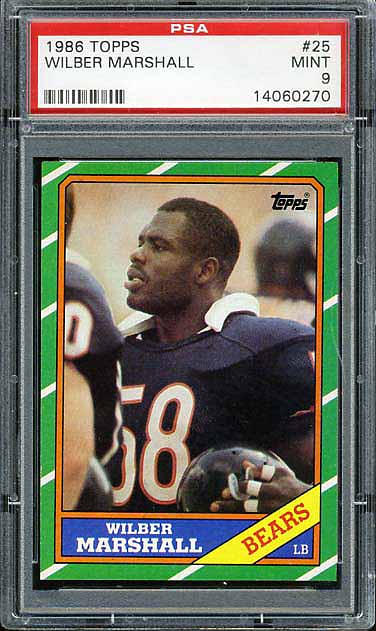
Marshall was the Bears first round pick in 1984. He was brought along slowly in his rookie year, spending most of his time playing special teams. When he was elevated to the starting lineup the next year, it coincided with Chicago putting together a magical season where the defense led the league in virtually every category possible.
The wrinkle that was perhaps most important was the versatility Marshall brought them. In the frenzied blitz scheme Chicago ran, his ability to blitz and cover opposing receivers was crucial. He had a career high six sacks and four interceptions as the Bears would go on to win Super Bowl XX. His fumble recovery against the Los Angeles Rams in the NFC Championship resulted in a 52 yard scamper into the end zone, and he had a sack and fumble recovery in the Super Bowl.
He made his first Pro Bowl in 1986, as well as being named First Team All-Pro, after getting 5.5 sacks and a career best five interceptions. One interception was returned a career long 58 yards for a touchdown, and he also took a fumble recovery in for a score. He returned to the Pro Bowl again the next season, which was his last with the Bears.
There hadn't been a free agent player in 11 years to sign with another team in the NFL until Marshall signed with the Washington Redskins. It cost the Redskins two first round draft picks, which turned out to be wide receiver Wendall Davis and defensive end Trace Armstrong, to sign him. Marshall rewarded Washington for signing him by averaging over 124 tackles in his five years with them.
In 1991, the Redskins would win Super Bowl XXVI that was one of the better teams the NFL has seen in the past 30 years. They finished first overall in offense, setting several records along the way, and had an excellent defense that finished second overall in the league. Their defense gave up 14 points per game, which is very close to the 12.4 points allowed by the fabled 1985 Bears defense. Marshall again was a key reason for this.
He matched his career best mark of five interceptions, and returned one 54 yards for a score. He also forced a career best four fumbles, had 5.5 sacks, and 135 tackles. In the Redskins 41-10 dismantling of the Detroit Lions in the NFC Championship, he had three sacks. He also had another sack in the Super Bowl.
He made his final Pro Bowl in 1993, and was named First Team All-Pro, after matching his career high mark of six sacks. He also had a career best 138 tackles and collected two interceptions. One was returned for the final touchdown of his career. His contract expired, so he decided to reunite with former Bears defensive coordinator Buddy Ryan in Houston as a member of the Oilers.
It was a season that saw him miss six games because of injuries, though he did collect two sacks. When Ryan accepted the head coaching job with the Arizona Cardinals in 1994, Marshall went with him and started all 15 games he played. He then joined the New York Jets in 1995 and had two interceptions and a sack in a mostly reserve role. He retired after that year.
Of the 45 sacks he had in his 12 seasons as a player, 16.5 came in his four years in Chicago. He also had none of his 23 interceptions with the Bears, and his 295 tackles still ranks 19th best in franchise history. His time as a Bear was short, but no one can deny the tremendous impact Wilbur Marshall had. The franchises lone Super Bowl trophy serves as both proof and a symbol of his excellence.
Bones Weatherly, Otis Wilson, Jim Purnell, Gary Campbell, Ron Rivera, Jim Morrissey, special teams star Brenden Ayanbadejo, and Larry Morris deserve mention.
Linebacker : Doug Buffone

Buffone was drafted in the fourth round of the 1966 draft by the Bears. He spent his rookie year as a reserve, but earned a starting job the next year. He responded by scoring the only touchdown of his career off of a fumble recovery, and intercepted three balls.
He continued to be a steady and consistent player over the next eight years, and never missed a game. He was injured in the second game during the 1976 season, and missed the first 12 games of his career. It was also just the second season he failed to record an interception.
When he retired after the 1979 season, his 24 career interceptions were the most by a Bears linebacker and still are today. His 184 games were the most until Steve McMichael passed it in 1993, and still ranks second best. He had over 1,100 tackles in his career, and seven seasons of 100 tackles or more. He was the last Bear to have played under Hall of Famer George "Papa Bear" Halas when he retired.
The Bears have a rich tradition of Hall of Fame linebackers, especially at the middle linebacker position. I could not find a better player than Buffone, so he wins this spot because he is truly a Bears legend.
Strong Safety : Richie Petitbon

Petitbon was drafted by the Bears in the second round of the 1959 draft, and he started right away. He has three interceptions and returned one for a touchdown. He then had seven interceptions over the next two years.
His first Pro Bowl season was in 1962 by leading the NFL with 212 yards on 6 interceptions. One went 101 yards for a touchdown, which is a Bears record. It was the second longest in NFL history at the time, and is still fifth longest behind 13 other players.
The Bears won the 1963 NFL Championship, and Petitbon helped by swiping eight balls and returning them for 161 yards. One went 66 yards for a score. He secured the Bears 14-10 win in the championship by intercepting a pass in the end zone with 10 seconds left. He was once again named to the Pro Bowl.
Despite getting no interceptions in 1964, he returned to the Pro Bowl in both 1966 and 1967 with nine total interceptions over that time. He left the Bears after 1968 to join former Bears defensive coordinator George Allen with the Los Angeles Rams. After two seasons there, he followed the Hall of Famer Allen to Washington to join the Redskins. After five interceptions for 102 yards in 1971, he suited up for just three games the next year and recorded no interceptions for just the second time in his career. After the Redskins lost in Super Bowl VII, he retired.
After retiring as a player, Petitbon became a top notch defensive coordinator for the Redskins. He oversaw defenses that helped the Redskins win three of four Super Bowl appearances over ten years. He spent one season as the head coach of Washington, succeeding Hall of Famer Joe Gibbs, then retired.
His 37 interceptions with the Bears is the second most in team history, and was first until Gary Fencik surpassed it by one in 1986. His 643 return yards is far and away the most in franchise history, and his three touchdowns off interceptions is the second most. His 48 career interceptions still ranks 38th best in league history, and his 801 yards ranks 25th best.
There have few men to have an impact on the game of football the way Rich Petitbon has. He is probably the best safety to ever play for the Bears.
Gary Fencik, Dave Duerson, Todd Bell, Shaun Gayle, and Don Kindt deserve mention.
Free Safety : Roosevelt Taylor

Taylor joined the Bears as an undrafted free agent rookie in 1961. He was used as a reserve that year, which was the only season of his career he failed to intercept a pass.
He earned the starting job the next year, and would team with Rich Petitbon to be one of the premier safety tandems in all of football. He intercepted two balls and returned one for a score.
The 1963 season may have been his best. His nine interceptions led the league and was a career best, as was his 172 return yards. One was returned for a touchdown. He was named First Team All-Pro and to the Pro Bowl, which helped the Bears capture the NFL Championship.
The 1967 saw Taylor pick off five balls and take a fumble recovery in for a score. He made the Pro Bowl the next year for the final time in his career after getting three swipes. One went 96 yards for the final score of his career, and is tied with Hall of Famer Clyde "Bulldog" Turner as the second longest interception return in team history.
After playing in the first six games of 1969 with Chicago, he was traded to the San Francisco 49ers and had two interceptions in eight games. He followed that up with three picks in each of the next two years before joining the Washington Redskins in 1972.
Finding himself reunited with Petitbon and Hall of Fame coach George Allen, who was his defensive coordinator in Chicago until 1965, he started all 14 games and has an interception. The Redskins reached Super Bowl VII before losing to the undefeated Miami Dolphins 14-7. Taylor then retired.
His 23 interceptions with Chicago still ranks ninth best in Chicago franchise history, and his 414 return yards ranks fourth best. His three touchdowns via interceptions is tied as the most by any safety in team history, and is tied as the second most overall. He is also the first of two Bears free safeties, Mike Brown was the other in 2001, to be named First Team All-Pro.
Though Rosie Taylor played in the era of Hall of Fame free safety Willie Wood and Rams legend Ed Meador, he was an upper echelon player in his own right. He very well could be the best free safety Chicago ever saw wear a Bears jersey.
J.C. Caroline, Erich Barnes, Ray McLean, Mark Carrier, Mike Brown, and Doug Plank deserve mention.
Cornerback : Donnell Woolford

Woolford was drafted in the first round of the 1989 draft by the Bears. He earned the starting job right away and picked off three balls despite missing five games. The following season saw him get three more swipes, as well as two sacks, though he missed three more games due to injury.
The 1992 season may have been his best. He had a career high seven interceptions, 94 tackles, and returned the last 12 punts of his career for 127 yards. He had a career high 101 tackles the next year, to go with two interceptions. He was named to the Pro Bowl for his efforts.
His last year as a Bear was in 1996. He picked off six balls, and returned one for a touchdown. Woolford then joined the Pittsburgh Steelers in 1997, and started in 12 of the 15 games he played. He had four interceptions, then retired after the Steelers lost to the Denver Broncos in the AFC Championship.
His 32 interceptions with the Bears ranks as the third most in team history, and thost ever by a cornerback in franchise history. His 536 officially recorded tackles are the most ever by a Chicago cornerback and ranks seventh best overall. It is pretty evident he is one of the best cornerbacks ever in team history.
Cornerback : Bennie McRae

McRae was drafted in the second round of the 1962 draft by the Bears. He was a reserve in his rookie year, but still managed to return a lone interception 47 yards. He was named a starter the next year, and would stay at left cornerback for the remainder of his Bears career.
He had a touchdown off a career high six interceptions in 1963, helping Chicago reach the championship game. The Bears defeated the New York Giants 14-10 in the game, and McRae got his hands on one of the five interceptions thrown by Hall of Fame quarterback Y.A. Tittle, who played most of the game severely injured.
McRae's 1965 season saw him gain a career best 116 yards off of four interceptions. One ball was returned 89 yards for a touchdown, which is the seventh longest interception return in team history.
He scored twice off of five interceptions in 1967, then picked off four more balls the next year. He missed the first game of his career in 1970, then joined the Giants for eight games the next season. It was the only year in his career that he failed to create a turnover, so he retired.
Bennie McRae scored four times off of interceptions in his career, which is the most in team history. It was tied by safety Mike Brown in 2005. His 27 career interceptions are the fourth most ever by a Bear, and his 485 yards returned by interceptions ranks third. He is obviously one of the best defensive backs in the teams long history.
Allan Ellis, Walt Harris, Jerry Azumah, Dave Whitsell, Terry Schmidt, Leslie Frazier, Mike Richardson, and special teams star Larry Whigham deserve mention.
Kicker : Kevin Butler

Butler was drafted in the fourth round of the 1985 draft by the Bears. He had the best year of his career as a rookie, as the Bears went on to win Super Bowl XX. He made all of his career high 51 extra point attempts, and made a career best 31 field goals on 37 attempts. His 83.8 field goal percentage that year was also the best of his career. His 144 points led the NFL, and is still a team record.
He was also popular with his teammates, who nicknamed him "Butthead" for canceling his wedding date in training camp because it was set on the same day as when the Super Bowl was to be played that season.
He led the NFL with 41 field goal attempts the next year, and made 28. He scored 120 points that year, which still ranks as the fifth most points scored in one year in Bears history. He exceeded the century mark three more times in his career with Chicago, and six of his seasons rank in the top 20 as the highest scoring seasons in team history.
In 1993, he made a career best five field goals, on eight attempts, of 50 yards or further. It is still a team record, though Paul Edinger tied it in 2002. Butler also made four field goals of 50 yards or further in 1990, and that still ranks as the third most in team history.
He left the Bears after the 1995 season and Joined the Arizona Cardinals for seven games in 1996 after Greg Davis was hurt. He missed just five of 36 kicks with them. After kicking six games for them the next year, he was replaced by Joe Nedney after an injury. He then retired.
Keven Butler has attempted and made the most field goals and extra points in Bears history, and his 1,116 points scored with them is also the most ever by any Bear. He may be the greatest placekicker to ever wear their uniform.
Bob Snyder, Jack Manders, Frank Maznicki, Hunk Anderson, Mac Percival, Paul Edinger, Ray McLean, and Bob Thomas deserve mention. McLean drop-kicked an extra point in the 1941 NFL Championship game, and it would be the last drop-kick in the NFL until Doug Flutie duplicated the feat in 2006.
Punter : Bobby Joe Green

Bobby Joe was drafted in the ninth round of the 1959 draft by the San Francisco 49ers, but ended up being cut and did not play football that season. The Pittsburgh Steelers signed him as a free agent in 1960, and he led the NFL with 64 punts for 2,889 yards. He also led the league with a career long 74 yard effort.
He averaged a career best 47 yards per punt and 3,431 yards the next year, on 73 attempts. The Steelers also asked him to kick the only field goal attempt of his career, but he missed.
He then joined the Bears in 1962 in exchange for Ed Brown, and would spend the rest of his career with Chicago. His punting in 1963, where he averaged 46.5 yards on 64 attempts, helped Chicago capture the NFL Championship. In 1966, he led the league with 80 punts for 3,358 yards.
The 1970 season saw Green become the first Bears punter ever to be named to the Pro Bowl after he had a career high 83 punts that totaled 3,395 yards. He led the NFL with 82 attempts in 1973, then he retired.
So far, he still is the only punter to ever make the Pro Bowl for the franchise. His 35,057 punting yards with them is the most in franchise history, and his 833 attempts rank as the second most.
His 41,317 career yards still rank as the 21st best in NFL history, and his 970 attempts are the 24th most. His 1961 and 1963 seasons both rank in the top 50 in NFL history as the best single season punting averages in NFL history, and his 42.6 career average ranks 59th best.
There should be little question to the fact that Bobby Joe Green is the best punter the Bears ever had play for them.
Ed Brown and Bob Parsons deserve mention.
Kick Returner : Cecil Turner

Cecil was drafted in the fifth round of the 1968 draft by the Chicago Bears. Cecil was one of the ten fastest men in the world at the time, but gave up the Olympics to play in the NFL.
He spent his rookie year as a reserve flanker, catching a career high 14 passes. He scored the only two receiving touchdowns of his career, taking one for a career long 80 yards. He averaged 32.6 yards per kick return the next year, with a long of 74 yards.
Now, primarily used as a kick returner, Turner exploded in 1970. He made his only Pro Bowl that year, when he tied a still-standing NFL single season record by taking four kickoffs for touchdowns.He averaged a career high 32.7 yards on 23 returns.They would be the last touchdowns of his career.
He returned a career best 34 kickoffs the next season, but was a part-time returner the next two year. He was out of the NFL after the 1973 season, but his 2,616 kickoff return yards still rank fifth best in team history.
Jerry Azumah, Glyn Milburn, Dennis Gentry, Ron Smith, Brian Baschnagel, and Johnny Morris deserve mention.
Punt Returner : Dennis McKinnon

McKinnon joined the Bears in 1983 as an undrafted free agent. He started three games that year at wide receiver, and was able to grab 20 balls and score four times. He also scored another touchdown on a 59 yard punt return on 34 attempts.
Chicago had him return just nine punts over the next two years so he could focus on being a starting receiver. His best year may have been in the Bears 1985 championship season, where he scored a career best seven touchdowns on 34 receptions. He also averaged a career high 17.9 yards per catch. He caught two touchdown passes in the first playoff game against the New York Giants, as the Bears rolled to a 21-0 win.
Though he missed the 1986 season because of injury, Chicago asked him to return punts full time again in 1987. He had a career high 40 returns for 405 yards in 1988. He also set a team record by returning two punts for touchdowns. One came off a league leading 94 yard return that was also a record until Johnny Bailey passed it by one yard in 1990.
He caught a career best 45 passes for 704 yards the next year, and also rushed a ball in for a score. His biggest game that year came in the first round playoff game against the Philadelphia Eagles. In a game known as the "Fog Bowl", visibility was virtually nil due to the thick fog that covered Soldier Field in Chicago. He scored the first of only two touchdowns scored that day on a 64 yard pass, and ended up with a team leading four receptions for 108 yards in the Bears 20-12 win.
After returning 34 punts that season, he was asked to return just 10 more in 1989. It was his last as a Bear, because he joined the Dallas Cowboys in 1990. He played in a career low nine games that season, then retired.
His 1,191 punt return yards rank third best in team history, and he ranks 20th in receptions. Devin Hester passed his record for punt return touchdowns in a season, and Hall of Famer George McAfee holds the NFL record for a career average of 12.8 yards per return. Though both men rank ahead of him on the teams list of punt return yards, Bears fans recall the versatile McKinnon as an integral part of some excellent teams.
Steve Shubert, Ray McLean, R.W. McQuarters, and Jeff Fisher deserve mention.








































